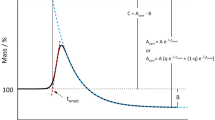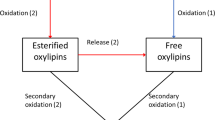Abstract
EVIDENCE has recently been presented which demonstrated the effects of alteration of the chemical composition of the stationary liquid upon the resolution of the methyl esters of long-chain saturated and unsaturated fatty acids by gas-liquid chromatography1–4. When the adipate, glutarate and succinate polyesters of diethylene glycol were used as liquid phases, the more polar unsaturated fatty acid esters were retained on the column to a greater degree than the saturated members of similar carbon chain-length. The number and position of the unsaturated linkages appeared to be the dominating factors in determining the affinity of the component vapour for the stationary liquid. The greater the degree of unsaturation beyond the 9,10 position in the fatty acid ester molecule, the slower was the movement of the substance down the column. This effect appeared to be modified somewhat by the occurrence of a double bond closer to the carboxyl group, that is, before the 9,10 position, which tended to hasten the emergence of the compound from the column. Although the polyesters were much more efficient as stationary liquids than the comparatively non-polar ‘Apiezon’ and silicone greases5,6 for achieving separations of saturated and unsaturated fatty acid esters, when samples of fatty acid esters of unknown composition were analysed by gas-liquid chromatography, the possible presence of esters of branched-chain acids, odd-numbered acids, and unusual mono-, di- and poly-unsaturated acids still made difficult the positive identification of the individual components on the basis of comparative retention times and volumes.
This is a preview of subscription content, access via your institution
Access options
Subscribe to this journal
Receive 51 print issues and online access
$199.00 per year
only $3.90 per issue
Buy this article
- Purchase on Springer Link
- Instant access to full article PDF
Prices may be subject to local taxes which are calculated during checkout
Similar content being viewed by others
References
Lipsky, S. R., and Landowne, R. A., Biochim. Biophys. Acta, 27, 666 (1958).
Lipsky, S. R., and Landowne, R. A., Fed. Proc., 17, 265 (1958).
Lipsky, S. R., and Landowne, R. A., Ann. N.Y. Acad. Sci. (in the press).
Lipsky, S. R., and Landowne, R. A., Biochim. Biophys. Acta (in the press).
James, A. T., and Martin, A. J. P., Biochem. J., 63, 144 (1956).
Cropper, F. R., and Heywood, A., Nature, 174, 1063 (1954).
James, A. T., and Webb, J., Biochem. J., 66, 515 (1957).
Lipsky, S. R., and Landowne, R. A. (unpublished results).
Author information
Authors and Affiliations
Rights and permissions
About this article
Cite this article
LANDOWNE, R., LIPSKY, S. Detection of Certain Brominated Long-Chain Fatty Acid Esters by Gas Liquid Chromatography. Nature 182, 1731–1732 (1958). https://doi.org/10.1038/1821731a0
Issue Date:
DOI: https://doi.org/10.1038/1821731a0
This article is cited by
-
Subtraction method and its application in gas chromatography
Fresenius' Zeitschrift für analytische Chemie (1979)
-
Determination of brominated vegetable oils in soft drinks by gas liquid chromatography
Journal of the American Oil Chemists' Society (1969)
-
Fatty acids of cows' milk. B. Composition by gas‐liquid chromatography aided by other methods of fractionation
Journal of the American Oil Chemists' Society (1962)
-
A study of octadecenoic acids by gas‐liquid partition chromatography and infrared spectrophotometry
Journal of the American Oil Chemists' Society (1960)
-
Quantitative fatty acid analysis of vegetable oils by gas‐liquid chromatography
Journal of the American Oil Chemists' Society (1959)
Comments
By submitting a comment you agree to abide by our Terms and Community Guidelines. If you find something abusive or that does not comply with our terms or guidelines please flag it as inappropriate.



